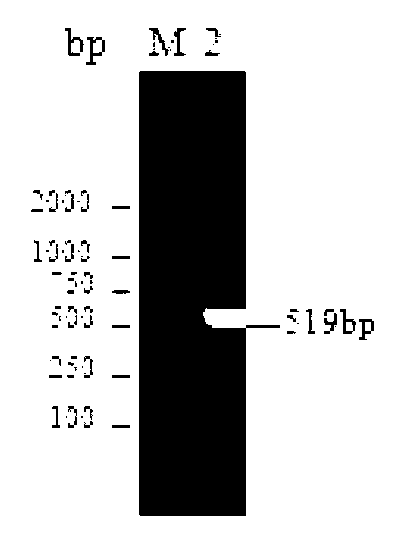Construction and expression for campylobacter jejuni cytolethaldistending toxin expression vectors, and preparation for monoclonal antibody
A technology of campylobacter jejuni and monoclonal antibody, applied in the direction of using vectors to introduce foreign genetic material, anti-bacterial immunoglobulin, and microbial-based methods, which can solve problems such as extraction difficulties
- Summary
- Abstract
- Description
- Claims
- Application Information
AI Technical Summary
Problems solved by technology
Method used
Image
Examples
Embodiment 1
[0032] Embodiment 1, amplification of cdtC gene
[0033] Primers were designed according to the sequence of the cdtC gene published on GenBank. The designed primers did not contain a signal peptide. The primer sequences were as follows:
[0034] cdtC: F (with BamH I restriction site): TAG GATCCT GGATGATAGCAGGGGATTTTAAC (SEQ ID NO. 1)
[0035] R (with XhoI restriction site): ATCTCGA GTCTT ATTCTAAAGGGGTAGC (SEQ ID NO. 2)
[0036] Using the genomic DNA of Campylobacter jejuni standard strain NCTC11168 as a template, the amplification system is: the total reaction system of PCR is 50 μl:
[0037]
[0038] The PCR cycle parameters were: pre-denaturation at 94°C for 10 min; denaturation at 94°C for 1 min, annealing at 60°C for 1 min, extension at 72°C for 1 min, 35 cycles, and extension at 72°C for 10 min.
[0039] Take 5ul of the PCR product, use 1.2% agarose gel electrophoresis for identification, and recover the product.
Embodiment 2
[0040] Embodiment 2, the connection of PCR product and cloning vector
[0041] The product recovered by PCR of the cdtC gene was connected to the cloning vector, and the recombinant plasmid after connection was subjected to BamH I and Xho I double enzymes to obtain fragments of 699bp and 2.7kb, 519bp and 2.7kb respectively, which were in line with the expected size, and the sequencing results were also It was shown that the cdtC gene sequence obtained in the experiment was completely consistent with the cdtC gene sequence of the NCTC11168 standard strain.
Embodiment 3
[0042] Example 3, Construction and Identification of Recombinant Prokaryotic Expression Plasmids pET-cdtC and pGEX-6p-1-cdtC
[0043]Use the gel recovery kit to purify the cdtC fragment of interest, connect it with enzyme-cut pGEX-6p-1, pET expression vector, transfer it into DH5α competent bacteria, screen with blue and white spots, expand the culture, extract the plasmid, and identify it by enzyme digestion. After the identification is correct Transform the plasmids pET-cdtC and pGEX-6p-1-cdtC into BL21 and BL21(DE3) competent bacteria, transform the recombinant plasmid of pET into BL21(DE3) competent bacteria, and transform the recombinant plasmid of pGEX-6p-1 into BL21 For competent bacteria, pick a single colony, expand the culture, extract the plasmid, and identify it by enzyme digestion. After the recombinant expression vector pET-cdtC was digested with BamH I and Xho I, two bands of about 5.9kb and 519bp appeared in electrophoresis. After the recombinant expression vecto
PUM
 Login to view more
Login to view more Abstract
Description
Claims
Application Information
 Login to view more
Login to view more - R&D Engineer
- R&D Manager
- IP Professional
- Industry Leading Data Capabilities
- Powerful AI technology
- Patent DNA Extraction
Browse by: Latest US Patents, China's latest patents, Technical Efficacy Thesaurus, Application Domain, Technology Topic.
© 2024 PatSnap. All rights reserved.Legal|Privacy policy|Modern Slavery Act Transparency Statement|Sitemap



